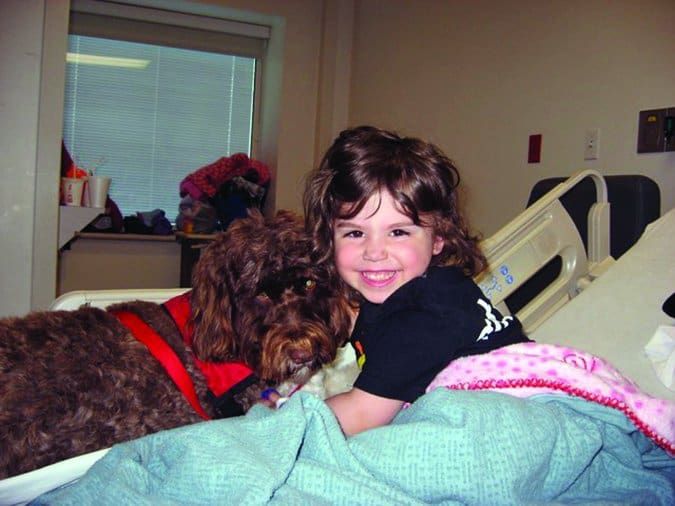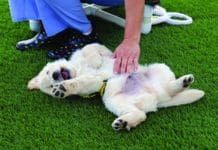Here is a tale of two headlines that appeared on October 5, 2018. The first exclaimed, “Therapy Dogs Can Spread Superbugs to Children, Johns Hopkins Study Finds.” The second said, “Medical ‘Dog Wash’ Cuts Risk of MRSA Spread from Therapy Dogs: Pilot study of intervention in pediatric oncology ward shows promising results.” Only the first headline went viral – and that’s a shame, because only genuine, unsolvable risks ought to sideline therapy dogs and their handlers.
The stories came from a press conference held during “ID Week,” a meeting of the Infectious Diseases Society of America in San Francisco, co-sponsored by the Pediatric Infectious Diseases Society, the Society for Healthcare Epidemiology of America, and the HIV Medical Association.
Concerns Over Therapy Dogs Carrying Methicillin-Resistant Staphylococcus Aureus
As the conference reported, physicians at Johns Hopkins Hospital in Baltimore suspected that therapy dogs might pose an infection risk to patients with weakened immune systems, so they tested four therapy dogs (Pippi, Poppy, Badger, and Winnie) as they visited 45 patients ages two to 20 who were undergoing cancer treatment and who did not have Methicillin-Resistant Staphylococcus aureus, or MRSA, the antibiotic-resistant infection feared by hospitals and nursing homes.
In different settings and sessions, the young patients petted, hugged, kissed, played fetch with, and brushed the dogs. “It’s amazing to watch just how excited the children get when they see the dogs for the first time,” says Johns Hopkins PhD candidate Kathryn Dalton, VMD, MPH. “The visits are really helpful in easing their anxiety and stress.”
As Dr. Dalton explains, “We wanted to explore the risk for a therapy dog to serve as a vector for the spread of hospital-associated pathogens, such as MRSA, to patients within a pediatric oncology clinic.”
© Monkey Business Images / Dreamstime.com

Studying Therapy Dogs as Carriers for Bacteria
The therapy dogs and patients were examined over 13 visits in 2016 and 2017. During seven control visits, the dogs received “normal pre-visit practices,” which include bathing and grooming, and on arrival at the hospital the dogs were considered “generally clean of MRSA.” At the end of the visits, 10 percent of samples taken from patients tested positive for the bacteria, and so did nearly 40 percent of samples taken from the visiting dogs.
As Johns Hopkins public health researcher and veterinarian Meghan Davis, DVM, explained, “Our hypothesis is that it’s really person-to-person transmission, but it happened through contact with the fur.” Hospital protocols require therapy dogs to be bathed within a day of their visits and checked for wounds or other health problems. The children who see them are supposed to use hand sanitizer, but, according to Dr. Dalton, “That wasn’t strictly enforced.”
In preparation for the study’s final visits, the dogs were bathed with an antibacterial shampoo, and every five to 10 minutes during visits they were treated with antibacterial wipes. The shampoo and wipes contained chlorohexidine, which came into medical use in the 1950s and which is used around the world to disinfect skin, sterilize surgical instruments, and clean wounds. Dozens of chlorhexidine products are sold for canine use.
Results
Those simple disinfecting steps, which are said to “decolonize” harmful bacteria, dramatically decreased the dogs’ bacterial levels, says Dr. Dalton.
The patients who interacted closely with the dogs were six times more likely to become MRSA carriers than those who did not interact closely. But when the dogs were decolonized, the close-interaction group’s risk for becoming MRSA carriers was no different from the group of patients who did not interact closely with the dogs.
Dr. Dalton hopes further study will show that such cleaning can reduce any risk of superbug infections. “I really had the opportunity to see how important these dogs were to the patients,” she says. “After the sessions with the dogs, the kids would say how much this made their day.”
Genetic studies in companion animals have shown that they tend to carry strains of bacteria distributed in humans or that they pick up strains from their owners or people they come in contact with, explains Dr. Davis. However, the results of this study apply only to pet therapy animals in an immune-compromised population. “We don’t recommend that you run out and treat every dog or cat,” she says.
The press conference’s moderator, Chris Nyquist, MD, of Children’s Hospital Colorado in Aurora, says that pet therapy has been limited in oncology patients because of concerns about infection transmission. The research project’s positive results, she says, will make it possible to expand the therapy dog program. The study found that patients receiving pet visits had decreased blood pressure, decreased heart rates, and improved mental health scores after visits with the dogs.
“This innovation of cleaning the dogs so they don’t become a vector for transmission is really important,” says Dr. Nyquist. “For humans, it’s washing your hands. This is a way of washing the dogs and making them as safe as possible in a very vulnerable population.”
The Johns Hopkins team has received additional funding to do a larger study looking at this intervention method in multiple hospitals. “Ours is the first study to look at this novel intervention,” says Dr. Dalton. “If we can safely learn whether this can be used in other settings, we can increase safety to [more] patients.”
Documenting the Path of Infection
MRSA isn’t the only infection that concerns public health officials and hospital administrators. Clostridium difficile, usually abbreviated C. diff, is a highly contagious bacterium that causes diarrhea and life-threatening inflammation of the colon, and diseases such as influenza and norovirus can be transmitted through physical contact as well.
In 2005, the Journal of Hospital Infection reported that an 11-year-old Border Collie acquired MRSA in a general hospital in the United Kingdom after visiting elderly patients. Both dog and owner were asymptomatic and had no apparent source of MRSA, but swabs collected after the visit tested positive for MRSA.
The report concluded, “It is suggested that pet therapy dogs can acquire and spread MRSA … Further studies are required to assess carriage sites and prevalence of MRSA in pet therapy dogs and the potential risk to patients.”
The following year, the medical journal Infection Control and Hospital Epidemiology published a report on canine visits to hospital patients in Ontario, Canada. Sandra Lefebvre, DVM, a veterinarian and PhD candidate in population medicine at the University of Guelph in Ontario, led a research team that conducted a cross-sectional survey of 231 hospitals, 223 of which allowed dogs to visit. Some were registered therapy dogs and others belonged to hospital visitors.
Of the 90 dog owners included in the study, 18 said they did not practice any infection control, 66 allowed their dogs on patients’ beds, 71 let their dogs lick patients, and 36 were unable to name any zoonotic diseases that may be transmitted by dogs.
The study concluded, “Although canine-visitation programs have become standard practice in non-acute human healthcare facilities, infection control and dog-screening practices are highly variable and potentially deficient. Hospital staff, visitation groups, pet owners, and veterinarians need to work together to protect both people and pets.”
In May 2006, Dr. Lefebvre announced the results of a separate study in which 102 visitation dogs from across Ontario were checked for 18 specific pathogens, including S. aureus. Fifty-eight percent carried C. difficile bacteria; other pathogens detected in the dogs were Salmonella, multidrug-resistant E. coli, and Pasteurella spp. None of the dogs carried S. aureus or its MRSA strain.
In a May 2009 letter to the Journal of Hospital Infection in London, Dr. Lefebvre described a 2007 study in which therapy dog teams visited long-term and acute-care facilities. The dogs were tested before and after visits for MRSA and C. difficile, and both were transferred to the dogs. She concluded that in order to contain the transmission of pathogens through contact with pet therapy animals, all patients and handlers should follow recommended hand sanitation procedures.
“The problem lies in the fact that dogs can carry disease-causing germs and still look healthy,” says Dr. Lefebvre. “Dogs can also pick up bacterial strains that originate in hospitals and transfer them to people in the community on a day-to-day basis. Hand washing before and after handling dogs is probably the best way to avoid contacting a zoonotic organism. Hand sanitizers are readily available in hospitals and nursing homes, and since dogs can’t do anything, it just makes sense that people should take extra precautions. Placing a sheet on patients’ beds or laps to protect them from direct contact with the dog is also a good way to protect both patients and dogs.”
Intermountain Therapy Animals

Dr. Lefebvre warns, however, “If there is any indication that a patient is infectious, that patient shouldn’t visit with a therapy dog in order to protect the people who handle the dog and to protect the dog.”
Despite the potential risk of transmitting illnesses directly or indirectly from dogs to humans, health officials and facility administrators are in no hurry to ban pet visits. As Heidi DiSalvo and fellow researchers concluded in their report “Utility of dogs in health care settings and infection control aspects” (American Journal of Infection Control, 2005), with careful planning and well-constructed policy guidelines, well-trained and healthy dogs can safely perform useful functions in therapy programs.
Researchers Sarah Brodie, Francis Biley, and Michael Shewring came to a similar conclusion in their 2002 article, “Exploration of the potential risks associated with using pet therapy in healthcare settings” in the Journal of Clinical Nursing. “A search of the literature has assessed potential and actual risk and concludes that the hazards are minimal,” they wrote. “The potential to suffer harm does exist, but it can be minimized by taking simple measures, including careful selection of animal and client, thorough planning and allocation of responsibility, rigorous health care of the animal, and informed practices by all involved.”
More recent reports in the medical literature show the same general result. Only a small number of studies listed at PubMed.gov in October 2018 mention infection risk while over 95 percent document the benefits of therapy dog visits to a variety of populations.
Infection Control in Therapy Dogs
Kathy Klotz, executive director of Intermountain Therapy Animals (ITA), headquartered in Salt Lake City, Utah, says infection prevention is a top priority for therapy dog organizations.
“ITA is committed to holding our teams to the very highest standards and in protecting the health and safety of our patients, our dogs, and our handlers,” she says. “We have always required that dogs visiting hospitals be freshly bathed, use an allergy deterrent, use barrier sheets on beds, and observe any and all additional requirements that a hospital may have. In the past few years we have instructed hospital teams not do any kind of ‘shake’ or ‘high 5′ interactions with patients in case the dogs’ paws pick up germs from the hospital floors.
“Those insidious germs are everywhere, outside the hospitals as well, so our handlers should take every precaution to make sure that they themselves are not affected by superbugs. Another concern for our hospital dogs is whether required disinfecting products could affect them adversely with constant use, and I am glad to know that our organization’s veterinarian considers 3-percent chlorohexidine disinfectants to be safe for this purpose.
“On a personal note,” she adds, “I wish that the media reporting on this study had focused less on the dire and scary parts and more on the balanced observations of the researchers themselves, who noted the importance of the dogs to the children’s well-being. But of course, I’m biased.”
Suggested Infection Control Guidelines
In March 2015, the Society for Healthcare Epidemiology of America (SHEA) published recommendations for policies regarding the use of animals in healthcare facilities, including animal-assisted activities, service animals, research animals, and personal pet visits to acute care hospitals. The guidelines were published in Infection Control & Hospital Epidemiology, the organization’s journal.
For animal-assisted activities (pet therapy visits), SHEA recommends that facilities develop a written policy for visits and designate an animal-assisted activity visit liaison; that animals and handlers be formally trained and evaluated; that infection prevention and control teams and clinical staff be educated about the program; that animal handlers have all required immunizations and prevent their animals from having contact with invasive devices; and that everyone who touches the animal practice hand hygiene before and after contact.
Protecting Visiting Therapy Dogs From Infection
MRSA is a concern to dog owners because it can infect and kill our best friends. It makes sense to help protect therapy dogs from not only MRSA but from any pathogens they might be exposed to during hospital or nursing home visits.
According to Mary G. Enig, PhD, an expert on dietary fats and oils, coconut oil’s medium-chain fatty acids inhibit the growth of many pathogenic microorganisms, including Staph bacteria. Coconut oil’s capryllic acid significantly reduces Salmonella and Campylobacter jejuni (another serious foodborne pathogen) when fed to chickens and other animals. In a 2005 study published in Molecular Cell Biochemistry (“Minimum inhibitory concentrations of herbal essential oils and monolaurin for gram-positive and gram-negative bacteria”) Dr. Enig tested two strains of S. aureus and found that monolaurin from coconut oil combined with the essential oil of oregano (itself a powerful disinfectant), worked better than the most potent antibiotic.
Intermountain Therapy Animals

She wrote, “This research showed that these safe antimicrobial agents could be useful for prevention and therapy of Staphylococcus aureus and numerous other infections. It is now clear and scientifically validated that the inclusion of coconut oil in the diet could and should be utilized for its preventive and healing properties.”
Give up to 1/2 teaspoon daily to a dog weighing 10 pounds, 1 teaspoon to dogs weighing 25 pounds, 11/2 teaspoons to a dog weighing 50 pounds, or 21/2 teaspoons to a dog weighing 100 pounds. These quantities represent about five percent of caloric needs for all sizes. Start with smaller amounts and increase gradually.
Oregano essential oil can be given to dogs by placing drops in an empty two-part gel cap (available at natural food markets), closing the cap, and placing it in a small amount of food so that the dog swallows it whole. Dogs do not like the taste!
When buying, be sure the label says Origanum vulgaris, preferably wild-crafted or organic. Use 1 drop of oregano oil per 50 pounds body weight once or twice per day. For small dogs, dilute 1 drop essential oil in 1/2 teaspoon vegetable oil and give 1/8 teaspoon per 10 to 15 pounds of the dog’s body weight.
The Johns Hopkins researchers studied decolonization with chlorohexidine, which is widely regarded as safe. However, some dogs develop skin irritation from its application, in which case microfiber cleaning cloths provide some protection, though their efficacy on therapy dogs remains untested.
Microfiber cleaning cloths are far more popular in Europe than in the U.S. Americans may be conditioned to consider disinfecting chemicals to be more effective than simple cloths that can be used dry or dampened with water. But research such as a 2016 study reported in the American Journal of Infection Control (“Improving operating room cleaning results with microfiber and steam technology”) and the July 2011 Journal of Hospital Infections (“Assessing the efficacy of different microfiber cloths at removing surface micro-organisms associated with healthcare-associated infections”) show that microfiber cloths can be an effective tool for reducing levels of MRSA, E. coli, C. difficile, and other pathogens on a variety of surfaces.
Rough-textured microfiber cloths made of polyester-polyamide were originally developed for “clean room” applications in the semiconductor industry. Used wet or dry, they attract and trap dust, dander, loose hair, and other particles. Microfiber fabric does not disinfect, but it picks up and removes bacteria, hair, and dander. Dogs can be wiped with clean microfiber cloths during therapy visits to minimize the transfer of potentially harmful bacteria from hands that pet them. Start with a clean folded cloth, wipe the dog with one side of the cloth, then fold it to expose a new surface for wiping later. The cloths can be microwaved or washed in hot water with bleach and dried in a hot dryer. Don’t use fabric softeners or dryer sheets, which reduce their effectiveness.
CJ Puotinen, who lives in Montana, has participated in animal-assisted therapy programs for 25 years. Her books include The Encyclopedia of Natural Pet Care.







My kids love to sleep with the dog everyday..